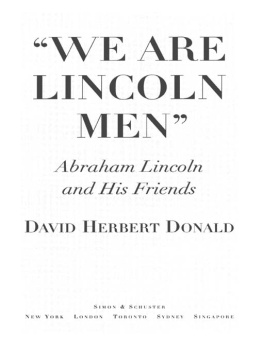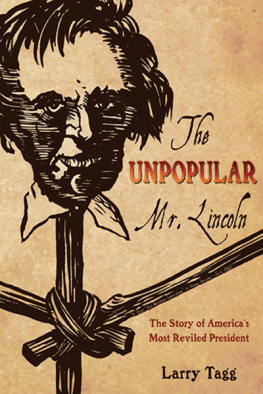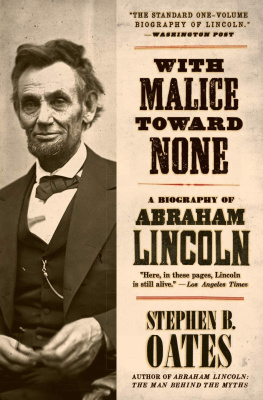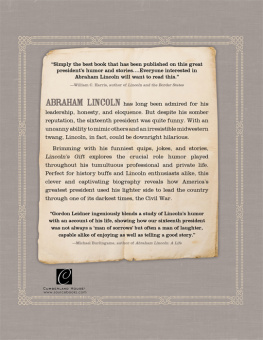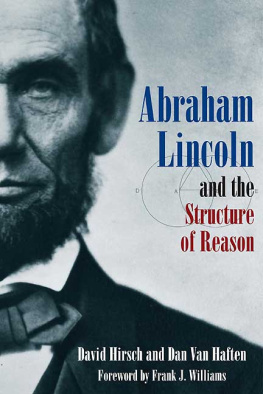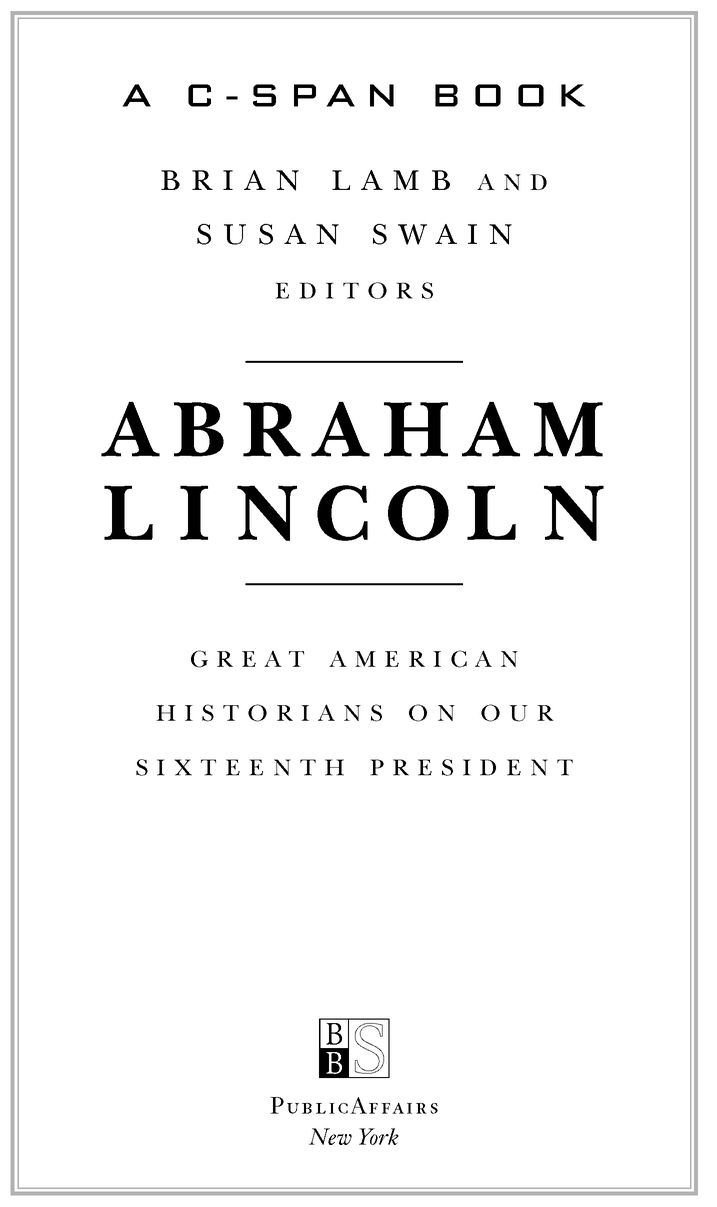Table of Contents
Readers can review an online supplemental appendix to Abraham Lincoln:
Great American Historians on Our Sixteenth President A C-SPAN Book on the
Internet at http://www.c-span.org/lincolnbook
Available on this C-SPAN Web page are:
Complete transcript of each featured authors interview
Video of each authors interview
A slideshow of photos from the book
Podcasts about the book and about Lincoln
Links to C-SPANs other Lincoln sites
To Harold Holzer, Peter Osnos, and Richard Norton Smith
great storytellers, all.
B. L., S. S., and all at C-SPAN
To Virginia, Frances, Patricia, and especially Marie.
S. S.
INTRODUCTION
In the summer of 1993, I was indulging in a regular habitscouting out new nonfiction releases at my local bookstore, the now-defunct Brentanos in Arlington, Virginiawhen I spotted an interesting title on top of a stack: Harold Holzers Lincoln-Douglas Debates. It was a history book with a contemporary connection: The 1992 campaign, and especially the quadrennial ritual of presidential debates, seemed to generate more than the usual amount of disparagement. Time and again, critics would invoke the 1858 matchup between Abraham Lincoln and incumbent Senator Stephen A. Douglas, the alternative to increasingly shallow and sound-bite-driven campaigns.
That chance encounter with Holzers book became the genesis of a sixteen-year relationship between our television network, C-SPAN, and the sixteenth president of the United States. It will come as no surprise, then, that C-SPAN has committed itself to being the television network of the Lincoln bicentennial, agreeing to cover many of the major events planned by a federally appointed bicentennial commission. Visitors to C-SPANs Web site (www.C-SPAN.org/Lincoln200years) can find hundreds of hours of our original Lincoln-related video, with more to come. Meanwhile, our friends at PublicAffairs, with whom we have published four previous books, joined forces with us to produce this edited collection of Lincoln essays, featuring the views and scholarship of more than fifty writers and historians drawn from C-SPANs programming archive.
Now, back to that Brentanos. Our sixteen-year interest in Lincoln began with Harold Holzer, co-chair of the Lincoln Bicentennial Commission and one of the nations best-regarded Lincoln scholars. When not dissecting Lincolns prose, Holzer serves as senior vice president for external affairs at New Yorks Metropolitan Museum of Art. Harold gave us an hour-long interview about his debate book for C-SPANs long-running author series, Booknotes. This was our introduction to the large, passionate, and sometimes tempestuous community of Lincoln scholars, amateur historians, archivists, writers, researchers, impersonators, museum curators, teachers, collectors, and critics, all of whom contribute to a national conversation about Lincoln that has been taking place for more than one hundred and fifty years.
Its a dialogue that constantly surprises. For example, from that initial Holzer interview, we learned that the Lincoln-Douglas debates, while historically significant, supply a poor model for candidates in the digital age, when bloggers and social networkers often set the pace for daily political coverage. Lincoln and Douglas met on seven stages across the state of Illinois. Each debate was three hours in length, much longer than nearly all of todays feature films. The 1858 version of one-on-one rhetorical combat consisted of an hour-long speech by one candidate, followed by a ninety-minute rebuttal, and then a half-hour closer by the initial debater.
This somewhat leisurely format became familiar to C-SPAN viewers in 1994 when we set out upon one of our most ambitious and rewarding productions everworking with all seven of those Illinois debate towns to re-stage each of the Lincoln-Douglas debates in its entirety. Then-colleague Maura Pierce spent hours on the phone, making connections in the relevant communities and piecing together a vast amount of research. C-SPANs education consultant for the projectmaster educator and longtime friend Dr. John Splainehelped spearhead the publication of a companion guide to the televised debates. Finally, in the late summer of 1994, C-SPAN producers and technicians descended upon the Illinois prairie, trailing in their wake production trucks, cameras, generators, and portable satellite uplinks.
On April 13, 1996, as a byproduct of the Lincoln-Douglas debates, I found myself in the basement ballroom of a Best Western hotel in Springfield, just blocks from the Illinois state capitol. I had agreed to be keynote speaker for the annual convention of the Abraham Lincoln Presenters. Looking out from the podium, I saw before me fifty-seven Abrahamstall, short, fat, and lean. There were bearded Abes and a few clean-shaven ones. Some sat side-by-side with their modern-day Marys; others worked the Lincoln circuit solo. My remarks to the group were window-dressing for in-depth sessions on the fine art of Lincoln presenting. One speaker offered advice that resonated when he told the assembled Abrahams, If you expect to be treated seriously, never work for free; charge at least $300 an event. Readers of this book, which has several descriptions of Lincolns relationship with money, might find themselves thinking that Lincoln himself would have agreed heartily with this counsel.
In the wake of our debates project, C-SPANs Lincoln coverage seemed to take root and flower in many directions. Reflecting the impressive number of new Lincoln book titles each year, their authors became a reliable part of Booknotess weekly interviews; Book TV, C-SPAN2s weekend nonfiction book channel, sent videojournalist Richard Hall to Gettysburg to tape hours of the Lincoln Forums annual discussion to air on our network; Mark Farkas, our networks executive producer for history, produced with his team several specials on the life and times of our sixteenth president; while the 2005 opening of the Abraham Lincoln Presidential Library and Museum led to several live telecasts from Springfield. Working with presidential historian Richard Norton Smith, the museums founding executive director, C-SPANs education department sponsored a national essay contest for high school seniors. The winner, then-eighteen-year-old Mihan Lee of Virginia, read her essay on Lincolns New Birth of Freedom, as part of the museums opening ceremony before President George W. Bush, a crowd of national and Illinois dignitaries, and other assembled Lincoln fans.
To this day, Abraham Lincoln remains elusive. His law partner William Herndon once referred to his friend as the most shut-mouthed man he ever knew. The many sides of Lincoln, first revealed to C-SPAN viewers through these interviews and special productions, are contained here in a single volume. Abraham Lincoln draws from C-SPAN interviews with some of the people best versed in United States history and in the history of Lincoln and the Civil War. It includes, as well, perspectives from a variety of other American writers who have sat before C-SPAN cameras.
Many aspects of the Lincoln story offer thought-provoking parallels to issues as fresh as this mornings headlines. The Abraham Lincoln that lives in these brief essays is much more compelling than the simple rail-splitter we know from schoolbook days.


